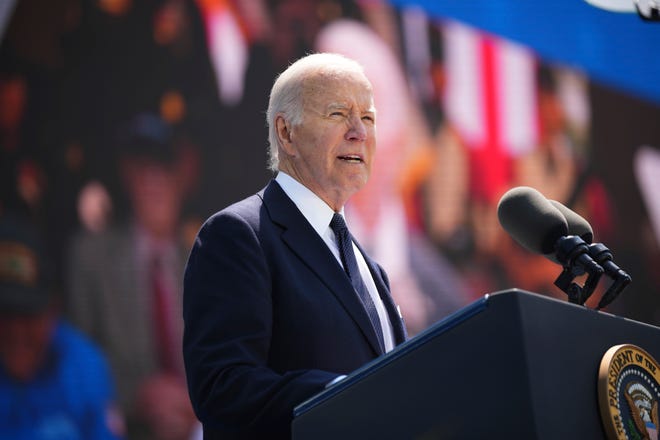Washington – President Joe Biden’s administration on Friday rolled back fuel economy standards set for new vehicle sales over the next decade as part of a move to balance its ambitions to fight climate change with harsh business and political realities.
The administration announced the final Corporate Average Fuel Economy standard, known as CAFE, a set of regulations that are the final piece of Biden’s vision for how big a role the auto industry should play in reducing U.S. greenhouse gas emissions. Biden also faces a tough re-election fight this fall against former President Donald Trump.
Under the final rule, automakers’ vehicles will have to achieve an average fuel economy of 53.5 miles per gallon by 2032, instead of the originally proposed standard of 57.8 miles per gallon.

“It seems like the left hand knew what the right hand was doing. That’s the coordination that we encouraged. So that’s a good thing, and we appreciate it,” said John Bozzella, president of the Alliance for Automotive Innovation, praising the Biden administration for crafting rules that are well aligned with others released earlier this year.
Biden’s new fuel economy standards remain ambitious. But his move away from the original CAFE proposal announced last year represents a compromise with automakers that are committed to reducing emissions but say they need more time. The move comes amid political polarization over zero-emissions electric vehicles — so far a shaky and unprofitable business for most domestic automakers.
Biden’s political rival, Donald Trump, vowed during the 2024 presidential campaign to repeal what he frequently calls an electric vehicle mandate.
The Biden administration’s rules don’t require automakers to build or sell any particular types of vehicles, but it’s widely acknowledged that a growing EV market will be crucial to meeting the new regulations.
The overall vehicle goal for 2023 is 53.5 miles per gallon, but this number varies greatly between cars and trucks: The goal for cars is 72.3 miles per gallon, compared to 47.3 miles per gallon for trucks, which are much more popular among U.S. consumers.
“This new standard will not only save Americans money on gas every time they fill up, it will also reduce harmful pollution and decrease our dependence on foreign oil,” U.S. Secretary of Transportation Pete Buttigieg said in a press release. “This standard will save car owners more than $600 on gasoline over the life of their vehicle.”
The new standards were officially announced by the National Highway Traffic Safety Administration, part of the Department of Transportation.
“When Congress enacted the Corporate Average Fuel Economy Program in the 1970s, the average car got about 13 miles per gallon. Under this new standard, the average light vehicle will get nearly four times that amount — 50 miles per gallon,” said NHTSA Deputy Administrator Sophie Shulman. “This new fuel economy standard will save our country billions of dollars, reduce our dependence on fossil fuels, and make the air cleaner for everyone. Americans will benefit from this rule for decades to come.”
Bozzella, whose group represents all major U.S. automakers except Tesla, said the increased standards and fines that would likely result from NHTSA’s initial proposal “would not produce any environmental benefits or fuel economy gains and would be a foolish move to divert automakers’ capital from the huge investments needed to transition to electric vehicles.”
General Motors also praised the rule.
“GM supports the goals of NHTSA’s final CAFE rules and their intent to significantly improve vehicle fuel economy across the market. The vehicle efficiency measures we’ve taken and the groundwork we’ve laid for an all-electric future will help us meet the more stringent requirements. As we work out the details, we believe continued coordination with the U.S. federal government and the California Air Resources Board will help ensure the auto industry makes a successful transition to electrification,” spokesman Bill Grotz said in a statement.
The CAFE rule was formally enacted by NHTSA and is the last of three major federal rules regulating pollution from consumer vehicles.
Other rules that were similarly scaled back after industry feedback came from the Environmental Protection Agency and Department of Energy. The EPA rule restricted how much carbon dioxide a vehicle’s tailpipe can emit, while the Energy Department rule adjusted a key calculation that affects an electric vehicle’s fuel economy score.
EPA:EPA’s final emissions rules give automakers more time to ramp up EV production
energy:Hidden energy calculations could dramatically accelerate America’s EV future
Despite announcing the weaker final rule, EPA Administrator Michael A. Regan called the rules “the strongest auto emissions technical standards ever finalized in U.S. history” at a March press conference.
Even if the CAFE rules are finalized, Biden still has one more decision on auto emissions to make, and perhaps the most important one.
California is seeking federal approval of even stricter standards starting in 2026 that 11 other states have already pledged to copy, which would effectively mandate a full shift to electric vehicles.
Biden is awaiting a decision on whether to approve a new exemption for California, which is seeking federal approval of tougher standards starting in 2026 that, unlike the administration’s rules, would explicitly mandate a full shift to electric vehicles.
email address

